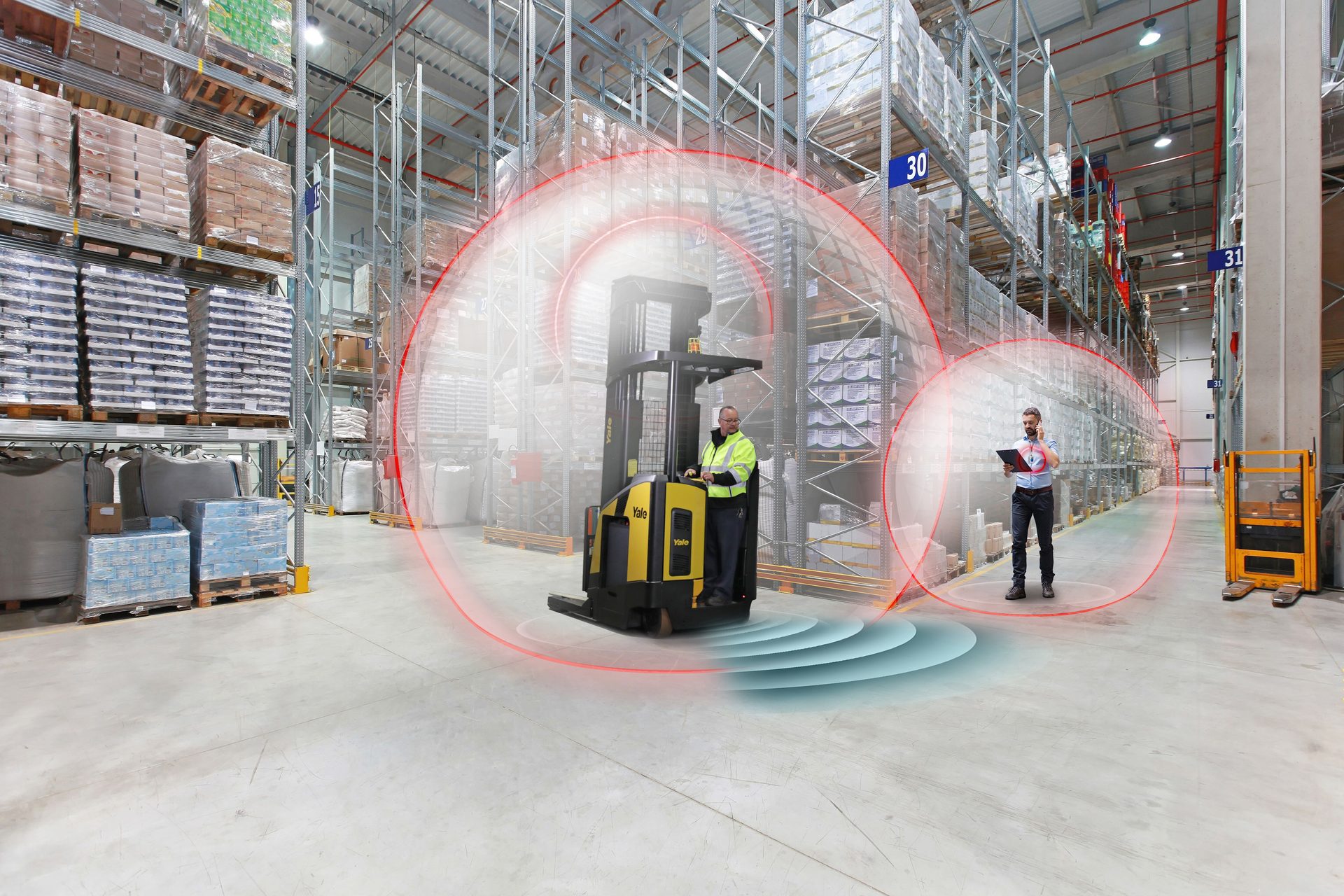Process automation maximizes performance
SUPPLY CHAIN LOGISTICS
Well suited to handle repetitive tasks and long runs, robotic lift trucks have advanced to accommodate a range of horizontal transportation and vertical storage tasks in many environments. Photo courtesy of Yale Lift Truck Technologies.
By Barbara Harfmann, Managing Editor
Dairy processing equipment market to reach $15.5B by 2029.
Like a car being made in an automotive assembly plant, the technology and equipment used to get — and track — real-time dairy data has improved tremendously over time. As today’s dairy processors churn out large volumes of milk, cheese, butter, ice cream and yogurt, many are reliant on automated material handling equipment and Warehouse Management Systems (WMS) to improve productivity, efficiency and accuracy.
In light of worker shortages, productivity is key, notes Mark Koffarnus, food and beverage major account director for Yale Lift Truck Technologies.
“The warehouse environment must be maximized to enable rather than hinder performance, which includes workspace and equipment being properly outfitted for productivity. A broad category of tools known as operator assist solutions can help lend lift truck operators a hand,” he explains.
The Greenville, N.C.-based company offers traditional forklift awareness tools, including lights and alarms, as well as technology systems that provide varying levels of support. These include stability control systems and an even more advanced solution: operator assistance technology.
While the stability control system receives inputs from maintenance-free sensors monitoring lift height, hydraulic load, mast tilt, truck speed and steer angle to apply automatic, real-time interventions, operator assistance technology takes it one step further — making operator and pedestrian safety a top priority.

“With automated systems in place, dairy plants can easily adjust their production schedules to meet changing demands or unexpected disruptions. They can even switch between different products or recipes on the fly, in some cases with minimum downtime or loss of productivity.”
— Adam Gurga, national manager of grocery and retail partnerships at Cimcorp Automation
“In practice, this technology can work to automatically slow down lift trucks if it detects pedestrians, other equipment or other obstructions in the area it’s monitoring,” Koffarnus explains. “It can also be used to limit speed in designated zones, prevent access to pedestrian-only areas, proactively reduce speed when traveling around corners to avoid upsetting stability and prevent trucks from moving loads that exceed weight threshold through hydraulic lock-out.”
While forklifts improve ergonomics in dairy plants of all shapes and sizes, there are a plethora of machinery and tools used in the production, processing, packaging and transportation of dairy products, according to Pune, India-based Exactitude Consultancy.
First, the research firm notes that the global dairy processing equipment market value is expected to reach $15.5 billion by 2029, growing at a compound annual growth rate (CAGR) of 6.2% between 2023-2029.
Secondly, as demand for nutritious dairy products continues to go up, particularly in developing countries, advances in technology and more efficient, automated dairy processing equipment is necessary.
Thirdly, “There is a growing trend toward the adoption of sustainable and eco-friendly dairy processing practices, which has resulted in the development of innovative equipment that reduces energy consumption and waste generation. The market is highly competitive,” the research consultancy firm states.
Investing in automation, maximizing output
In an effort to manage costs, worker shortages and, most importantly, to ensure availability of functional dairy products like drinkable yogurts, dairy processors are automating like never before, notes Adam Gurga, national manager of grocery and retail partnerships at Cimcorp Automation. The Alpharetta, Ga.-based company specializes in fresh food handling solutions.
“Well, dairy is a massive part of our food supply chain. And as demand for dairy products continues to change, so, too, does the pressure on dairy warehouses to adapt,” he says. “…First off, there's warehouse management software. This kind of software can help streamline operations by automating tasks like inventory management, order processing and shipping. With the right software in place, dairy warehouses can minimize errors, reduce waste and optimize their workflows to maximize output.”
Radio-frequency identification (RFID) tagging, which cost less than $1 per tag, is another critical, easily implemented technology that allows dairy warehouses to keep track of inventory in real-time, reduce theft and the risk of human error, and even automate certain processes like restocking and order fulfillment, Gurga adds.
But, No. 1 on the must-have list is automation itself. Gurga notes: “From overhead gantry robots that can pick, pack and build orders with incredible speed and accuracy, to [automated storage and retrieval systems (AS/RS) that can move and replenish inventory seamlessly through the warehouse, there's a quite substantial opportunity for efficiency gains.”
Other benefits of AS/RS is that it increases throughput, saves floor space, reduces stress on team members, maximizes production and increases speed to market, Gurga adds.
Measurable actions and trends
By leveraging the power of warehouse management software, RFID tagging and automation, dairy warehouses can ensure they’re churning out products faster, better and more accurately, experts note.
In its 2022 report on the global warehouse management systems (WMS) market, Dublin, Ireland-based Research and Markets prognosticates that the WMS market will grow by $1.78 billion, accelerating at a CAGR of 10.4% during the 2022-2026 forecast period.
On the material handling side of things — which is the movement of raw goods from point A to point B — Research and Markets anticipates the global market will rise at a 9.4% CAGR to $41.8 billion in 2023 and reach $59.9 billion in 2027, at a CAGR of 9%. The materials handling market includes automatic guided vehicles (AGVs), automatic identification and data collection, casters and wheels, controls, conveyors, dock equipment and ergonomics, it adds.
Research and Markets also notes the impact of the Russia-Ukraine war that continues to disrupt the chances of global economic recovery. “The war has led to economic sanctions on multiple countries, surge in commodity prices, and supply chain disruptions, causing inflation across goods and services affecting many markets across the globe,” it states.
Overhead gantry robots can pick, pack and build orders with 100% efficiency, incredible speed and pinpoint accuracy.
Photo courtesy of Cimcorp Automation.
Robotic lift trucks indispensable for repetitive tasks
Yales’ Koffarnus notes that robotics and automation adoption is expected to reach nearly 80% in the next five years, according to the 2022 MHI Annual Industry Report. “Robotic lift trucks (RLTs) have advanced to accommodate a range of horizontal transportation and vertical storage tasks in many environments,” he says. “RLTs are especially well suited to handle repetitive tasks and long runs, a valuable characteristic, considering that many customers today want to automate as much as they can due to high turnover in warehousing and the challenge of finding enough applicants to fill open positions.”
Yale’s robotic lift trucks are standard lift truck models with integrated robotic technology that, with navigation laser detects from a reference map, allow them to perceive and interact in real-time with its environment, making decisions autonomously. Yet, operators, with the touch of a button, can switch from autonomous operation to manual control.
“RLTs integrate easily with a navigation system that maps the existing physical structures of the warehouse such as walls, building columns or racks,” Koffarnus explains. “They can plan and modify paths quickly and can easily accommodate changes to the environment by having the truck perform a new ‘walk’ to re-map the facility.”
When it comes to case pick speed and accuracy, Cimcorp’s Multipick gantry robots are “lights out” when it comes to case pick speed and accuracy.
“We’ve been successful in providing a system that allows dairies to take advantage of their existing floor space for dense cubic storage, but at the same time creating a sanitary option where you can still access the floor for regular cleaning, which is absolutely critical for the dairy industry,” Gurga explains. “With traditional racking pick systems, it’s very tough to clean up leakers and other issues. With the Multipick, the robots move cases and open up floor space for access.
“From an efficiency standpoint, then gantry robots can infeed full stacks of cases directly from production into the storage area, then build custom mixed SKU stacks to satisfy outbound orders with 100% efficiency,” he continues. “It’s a major benefit for dairies, which traditionally see a lot of manual stacking.”
While larger dairy companies generally have more resources to invest in automation technology, smaller operations with more limited budgets that can’t build a new plant from the ground up could benefit from Cimcorp’s gantry Multipick. “Its modular design allows for installation in older buildings with low ceiling requirements,” Gurga notes. “Ultimately, the decision to invest in automation technology should be based on a careful analysis of the specific needs and goals of the business, and that’s where we can help.”
Operator assistance technology automatically slows down lift trucks if it detects pedestrians, other equipment or other obstructions in the area it’s monitoring. A hydraulic lock-out also prevents trucks from moving loads that exceed weight threshold.
Photo courtesy of Yale Lift Truck Technologies.

Healthier dairy products drive market growth
The dairy industry is experiencing growth due to the increasing demand for healthier dairy products that are low in fat, cholesterol and sugar, experts note. And making these better-for-you products also is requiring specialized processes such as ultrafiltration and automated control systems. Consumers desiring more flavor choices also is pushing dairy processors to develop innovative products that balance nutrition, taste and cost.
The best way to meet all of these converging needs is automation, according to Cimcorp’s Gurga.
“One way automation is helping dairy plants is by providing greater flexibility in production,” he notes. “With automated systems in place, dairy plants can easily adjust their production schedules to meet changing demands or unexpected disruptions. They can even switch between different products or recipes on the fly, in some cases with minimum downtime or loss of productivity.”
Automation also helps dairy plants increase throughput and their bottom line. “With automated systems handling everything from milk processing and packaging, to quality control and logistics, dairy plants can dramatically increase their output while maintaining the highest levels of quality and safety,” Gurga explains.
Future focus on customer-driven design
Investing in supply chain logistics and warehouse technologies requires software systems, technology and equipment to be seamlessly integrated — all centered on a customer-driven design — based on the specific environment its being used in.
“This emphasis on thoughtfully integrating technology on a smart lift truck foundation extends throughout our solutions, including warehouse innovations like operator assist systems, and provides a more comprehensive solution for facilities,” Yale’s Koffarnus explains. “Decision makers at warehouses and plants should look for an equipment manufacturer whose product design process focuses on addressing operational challenges, from labor productivity and safety to sustainability.”
Gurga expresses similar sentiments. “I think robotics and automation will continue to play a major role in the warehouse industry, with advancements in autonomous mobile robots, automated storage and retrieval systems, and robotic picking systems, for sure,” he concludes. “But I do see artificial intelligence and machine learning poised to transform the warehouse industry by enabling more accurate demand forecasting, optimizing inventory management, and improving overall efficiency. Data-driven decision making and partnering with the right automation company that listens and understands the dairy industry’s needs is critical to success.” DF
Automated storage and retrieval systems (AS/RS) can move and replenish inventory seamlessly through the warehouse, minimizing errors and increasing speed to market.
Photo courtesy of Cimcorp Automation.

APRIL 2023 | dairyfoods.com